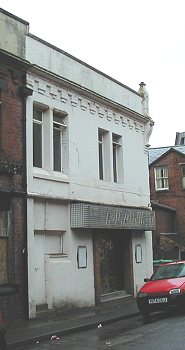George and Kath Peck had many
pleasant memories of the town centre, during the period between the two
world wars. Today shopping is mainly confined to a relatively small area,
which covers the Mander Centre and the adjacent streets. In those days there
were the main shops in the town centre, as there are today, but also many
others which were equally popular. Horseley Fields contained many shops as
did Piper's Row. Today Worcester Street has a run-down appearance, but in
those days its shops were very busy as were the ones in Chapel Ash..
|

George Peck. |
Shopping was a very different
experience from today. We are used to the hyper markets, where
almost everything is under one roof, which makes shopping very easy
and convenient. In those days there were lots of little shops, each
selling a relatively small range of goods and so shopping was a
lengthier and more personal event. When you frequented a small
corner shop you got to know the shopkeeper and the assistants, which
is very different from today's large stores. The shopkeeper would
soon be familiar with your wants and so would often order things
especially for you, so that they were in stock when you called. Life
ran at a slower pace, and people spent more time in the shops. |
In the 1920s and 30s there were just as many pubs in the town as today,
although not confined to such a small area. Many had reputations and some
were to be avoided. You could get into a lot of trouble at home if other
members of the family discovered that you had been seen in some of the
establishments. Pubs were not necessarily the warm friendly places that they
are today. In those days you would not dream of taking other members of the
family into some of the establishments. Such was their reputation.
| There were a number of cinemas in the town centre at
this time. Some catered for the poorer parts of the community
whereas other were more salubrious. This was before television
became popular and many people could still not afford a radio, so
the cinema was an important form of entertainment. Many people went
to the cinema frequently and seats would be provided for both the
poorer people and the better off. Most children at this time went to
the Saturday Matinee and so the cinema was an important part of
their entertainment from an early age.
The two main theatres were the Grand and the Empire Palace which
became the Hippodrome. Entertainment at the Empire Palace consisted
mainly of reviews, music hall and comedians, whereas at the Grand it
was plays, pantomime and the D'oyly Carte. The Grand was a touring
theatre and played host to visiting professional companies and local
amateur groups. |

The Olympia in Thornley Street
as it is today. |
The main cinemas in the town centre were:
| Agricultural Hall |
Snow Hill, began showing films about l913, closed in
1931. |
| Coliseum |
Dudley Road, opened in 1912. |
| Electric
Theatre |
Queen Square, opened in 1910, known as the Imperial in
1915, closed in about l918. |
| Empire Palace |
Queen Square, became the Hippodrome, in 1921, and a
cinema in 1931 until the Gaumont opened in 1932. |
| Gaumont |
Snow Hill, opened in 1932 replacing the Agricultural
Hall. |
| Odeon |
Skinner Street, opened in 1937. |
| Olympia |
Thornley Street. |
| Pavilion |
Castle Street. |
| Scala |
Worcester Street, opened December 1913
and was originally called the Picturedrome. |
| Queen's |
Queen Square, opened in 1914. |
George and Kath's memories cover most of the city centre and so they have
been divided into the following sections:
Sadly Kath died in 2002, and George died in March 2012.
Although they are now gone, their memories live on.
 |
|
 |
|
 |
Return to the
corner shop |
|
Return to
the arcade |
|
Proceed to
Lichfield Street |
|







